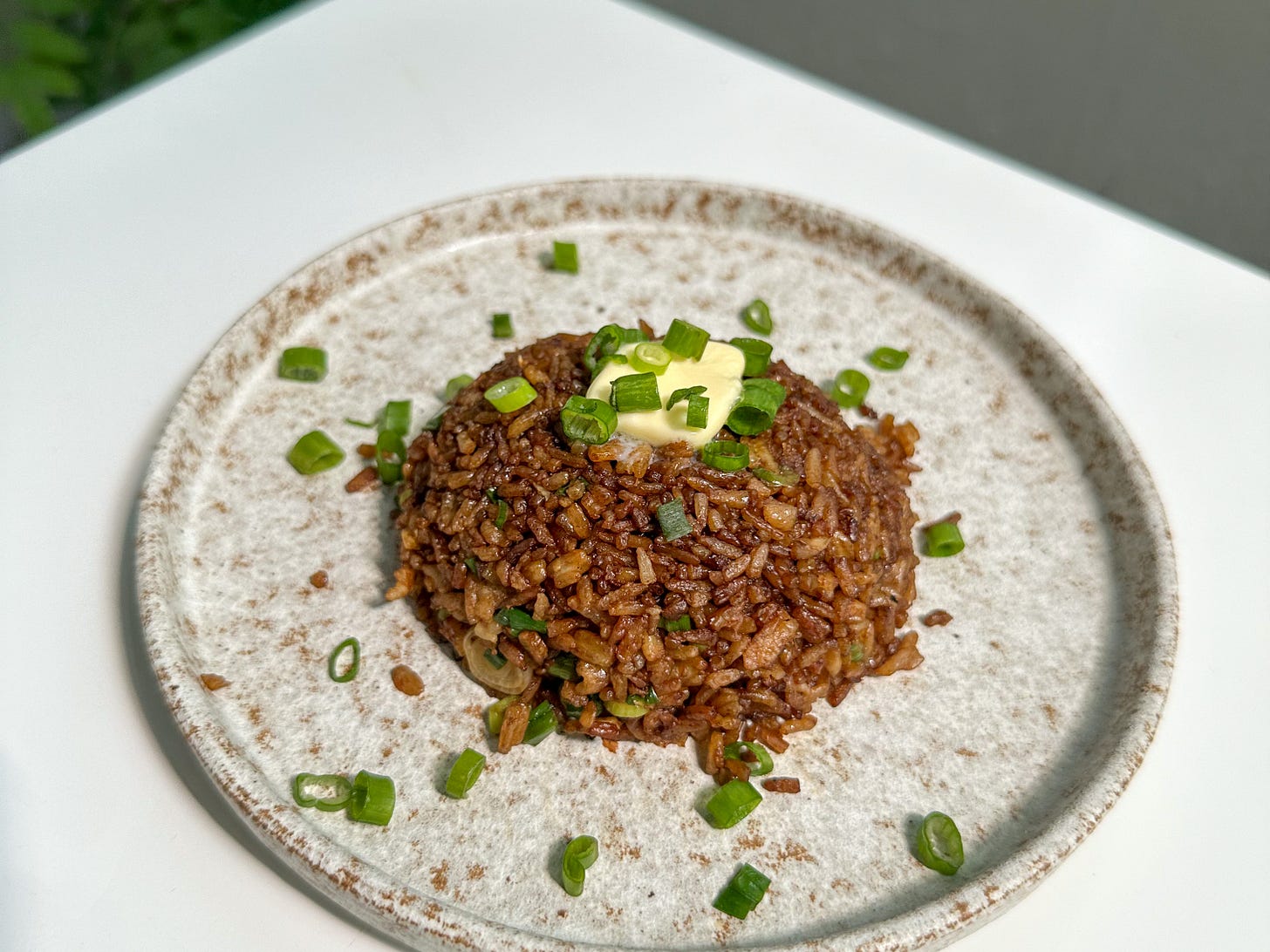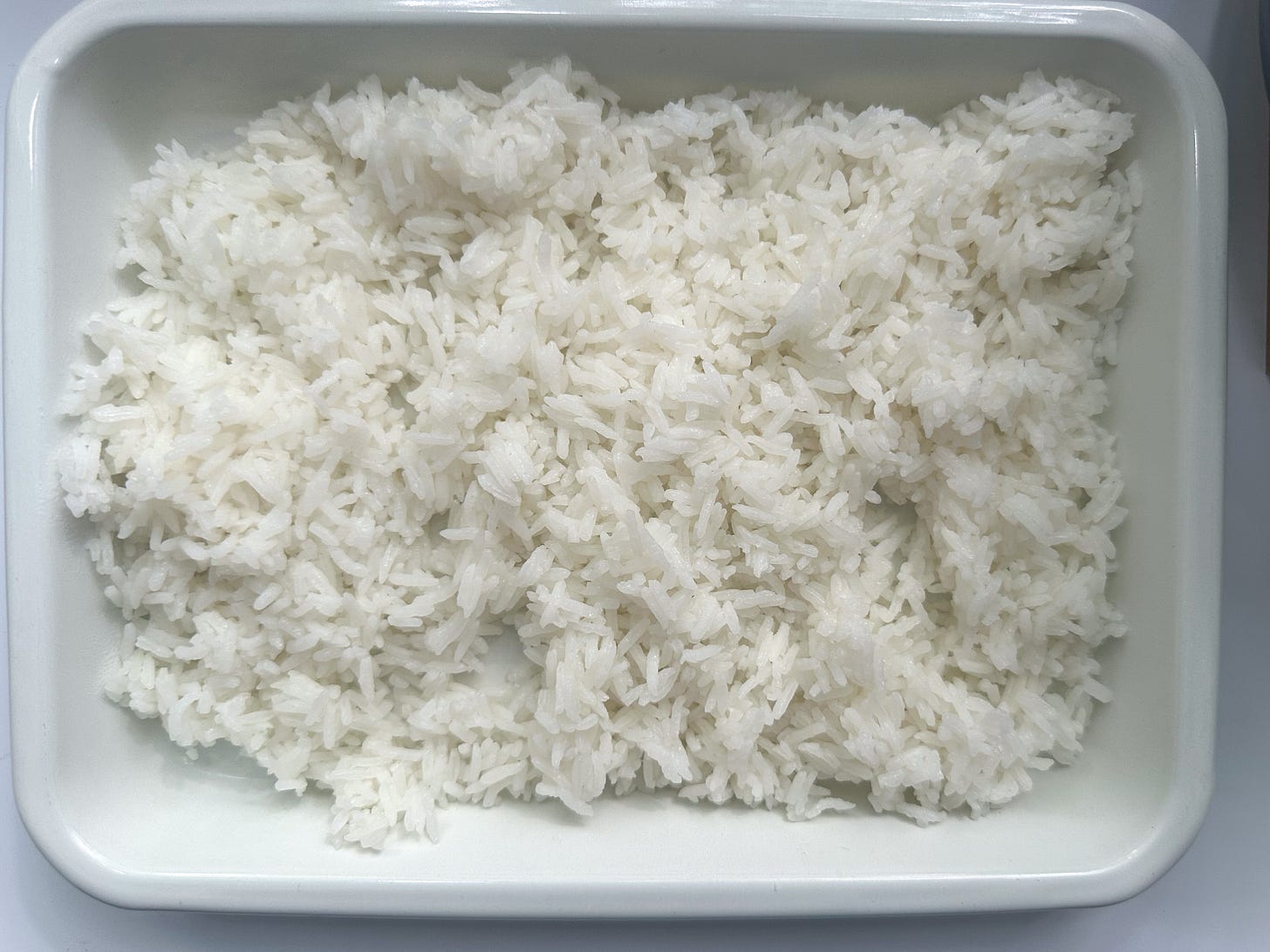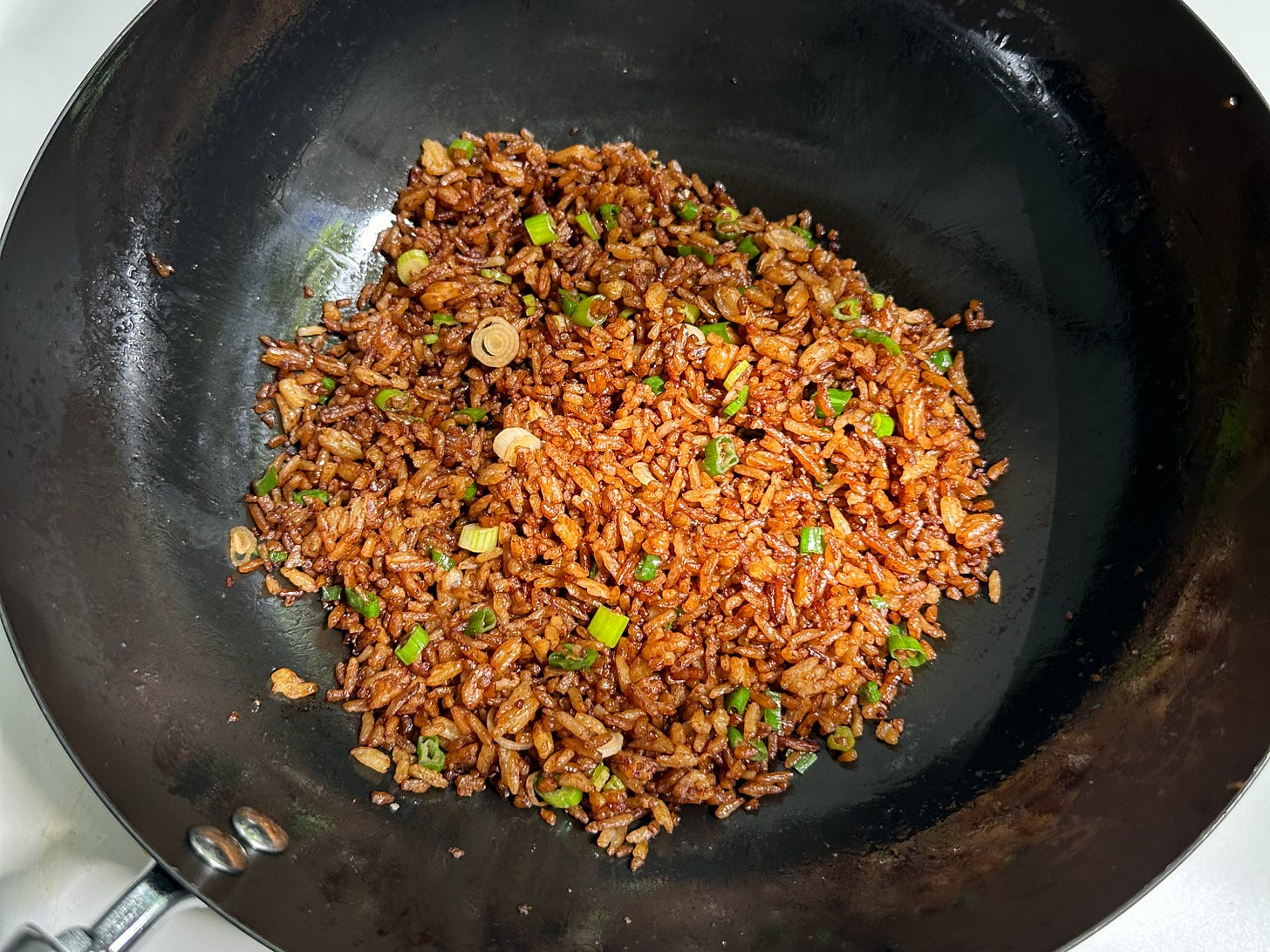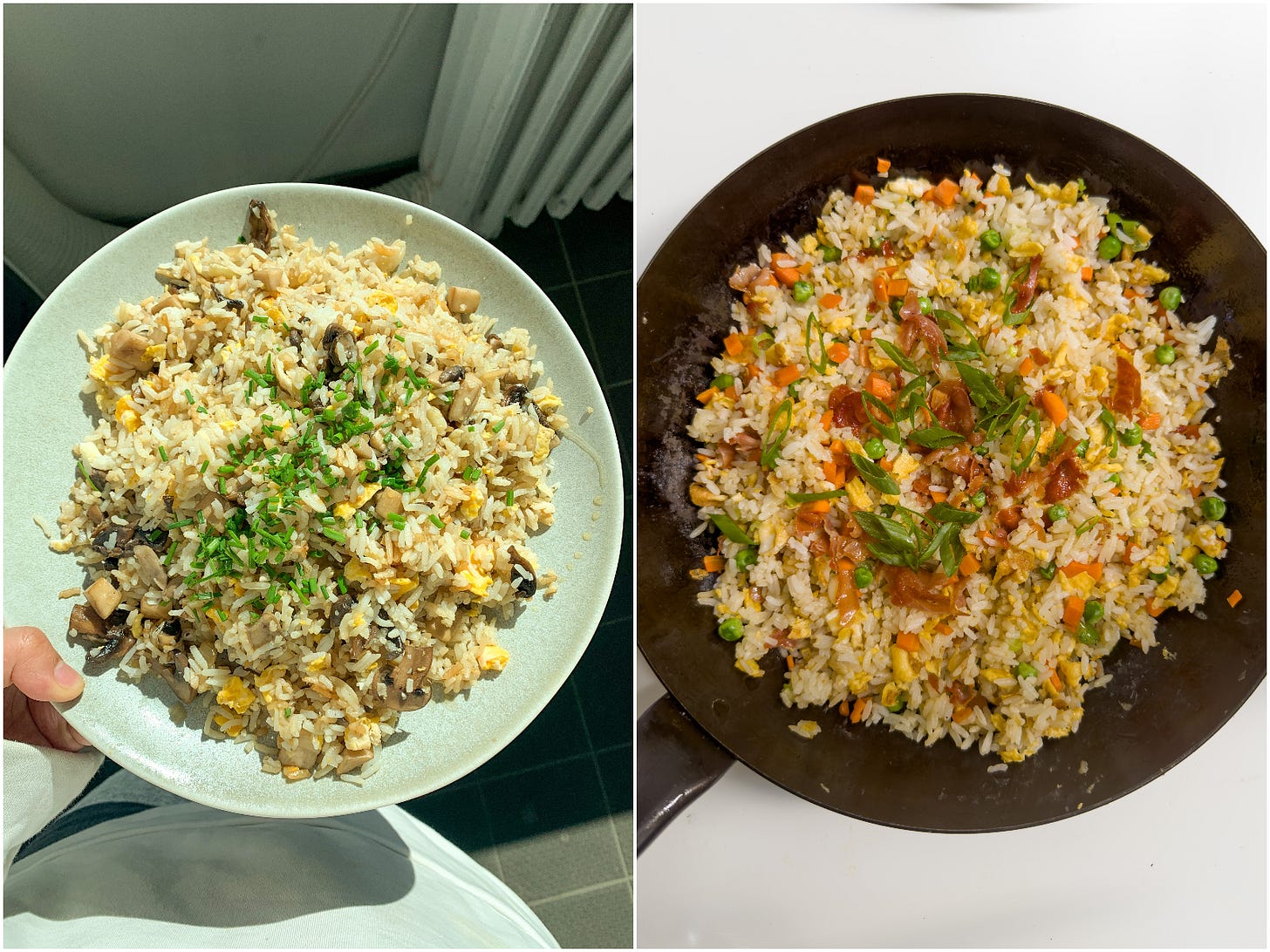Hi! This week, we’re making a simple recipe using two types of soy sauce, continuing the exploration of this archetypal Chinese ingredient from last week. Watch me make it here.
Soy sauce is a staple in my cooking, but when brainstorming recipe ideas to highlight this ingredient, I got stuck. Then, I remembered a plate of soy sauce fried rice I had in Shanghai last April. My college friend Zhaozhao, a local gourmet, took me to a fusion Hunan restaurant. Everything was fantastic, from century egg beef tartare to Iberico xiaolongbao. However, what impressed us most was their soy sauce fried rice. The rice was perfectly cooked, coated in a dark brown glaze, and mixed with chopped meigan cai (dry pickled mustard) and smoked pork. We instantly ordered a second plate.
Soy sauce fried rice is a dish that likely originated in regions near Shanghai1 but is enjoyed across the country. I’ve been a minimalist when it comes to fried rice sauce, usually using just a dash of light soy sauce and salt. Yet in my effort to recreate a simple version of this dish, the beany aroma and caramel notes from dark soy sauce really grew on me.
There’s a saying in Chinese: "The great truth lies in simplicity." (大道至简) Some of my favorite foods, like fried rice and scallion oil noodles, embody this philosophy. These dishes are also home-cooked staples for many Chinese of my parents' generation, who grew up with limited food resources. Leftover rice was fried with oil, lard, soy sauce, and egg to make a quick and affordable meal.
This is a recipe where you can tweak around and add more ingredients, scroll down for tips.
The Recipe
Serving: 1 (feel free to double!)
Ingredients
175 g cold, dry cooked rice (about 1 cup)
1 egg
1 tbsp vegetable oil
1 tsp dark soy sauce
1/2 tsp light soy sauce
1 scallion
salt
sugar
1 small piece of butter (optional)
sweet soy sauce or aromatic sweet soy sauce (optional)
Instructions
Crack an egg, season with salt, and whisk to combine. Break up the cold rice into small pieces if it sticks together.
In a wok or deep-frying pan, heat the oil over medium heat until hot, and swirl to coat the wok. Add the egg and fry until the edge is puffed up but the center is still runny. Add your rice, coat the rice in the egg, and break up the egg pieces. Stir-fry until the rice is no longer wet.
Add dark soy sauce in 2-3 batches, stir-frying in between to mix. Once your rice is nicely brown and dancing in the wok, add the light soy sauce. Season with a pinch of sugar and salt to taste. Mix to combine. Add chopped scallion, quickly stir-fry, and serve in a bowl. Add a piece of butter and some sweet soy sauce if desired.
Tips on making the best fried rice
Best fried rice is probably highly subjective, but here are some tips to improve from my many attempts. If you omit the dark soy sauce and add more light soy sauce or salt, it would be more like classic egg-fried rice.
What kind of rice to use?
Rice is the key to the success of this dish. If you get very wet and clumpy rice, make it into congee instead of fried rice. Chinese version normally uses medium-grain white rice, but jasmine rice is my default as it’s hard to get Chinese-produced rice here. Short-grain rice such as ushi rice could be too sticky.
Most fried rice calls for day-old cooked rice, which is also what I use most of the time. However, you can use fresh cooked rice for the day, as long as it’s cooled and not moist anymore. Spread a thin layer on a baking tray or big plate so it has enough space to let the moisture evaporate. Before cooking, break up any big clumps with your hand. In Kenji J. Alt-Lopez’s book The Wok, he recommends using fanned-cooled rice (freshly cooked, fanned for an hour to cool down).
Do I need a wok?
I’m not a wok purist, although I recently had a proper carbon steel wok that works on electric and induction and really fell in love with it. For years before that, I used all kinds of pans (non-stick, carbon steel, and cast iron) to make fried rice—it's a forgiving dish. You just have to have a big pan hot and fry the rice until it sizzles in the wok, making a crackling sound like it’s dancing. Don’t crowd the pan with too many ingredients, make 1-2 portions each batch.
Egg first or rice first?
These three methods are all widely used in Chinese recipes. Some chefs call the rice-first method "gold wrapping silver" (金包银) and the egg-first method the other way around (银包金). Some also only use egg yolks. I tried three versions:
Fry the whole or whisked egg first. Before the egg is completely set, add the rice and vigorously stir-fry. This is more of a middle ground where you can taste both the egg bits and some rice coated with the egg.
Separate the yolk and white and fry them separately before adding the rice. This will give you nicely golden egg bits from the yolk. For just a single portion, I find it a bit too time-consuming.
Add the whole raw egg to the rice and mix to combine. This method is easy in preparation as the egg helps separate the rice grains from each other. However, it takes a bit longer to stir-fry in the beginning, and there won’t be small bits of eggs.
How to upgrade your fried rice
Almost anything can be added to fried rice. Check your pantry and fridge for leftovers. In general, chop the ingredients into small pieces, stir-fry them in the wok until cooked, then set them aside. Proceed with cooking your fried rice and add the pre-cooked ingredients back in at the last stage.
Here are some ideas:
Alliums: Besides the classic scallion, red onion and shallots work great.
Pickles (great flavor enhancers): Zhacai (pickled mustard tuber), Yacai (pickled mustard), pickled radish.
Vegetables: Carrots, peas & edamame (frozen or fresh), potato, zucchini, cabbage, bok choy.
Cured meat and sausage (also great flavor enhancers): smoked pork belly, Cantonese sausage, or Spanish chorizo, bacon.
Other protein: minced meat, chicken, shrimp, beef steak, spam, sausage, cubed smoked or five-spiced tofu.
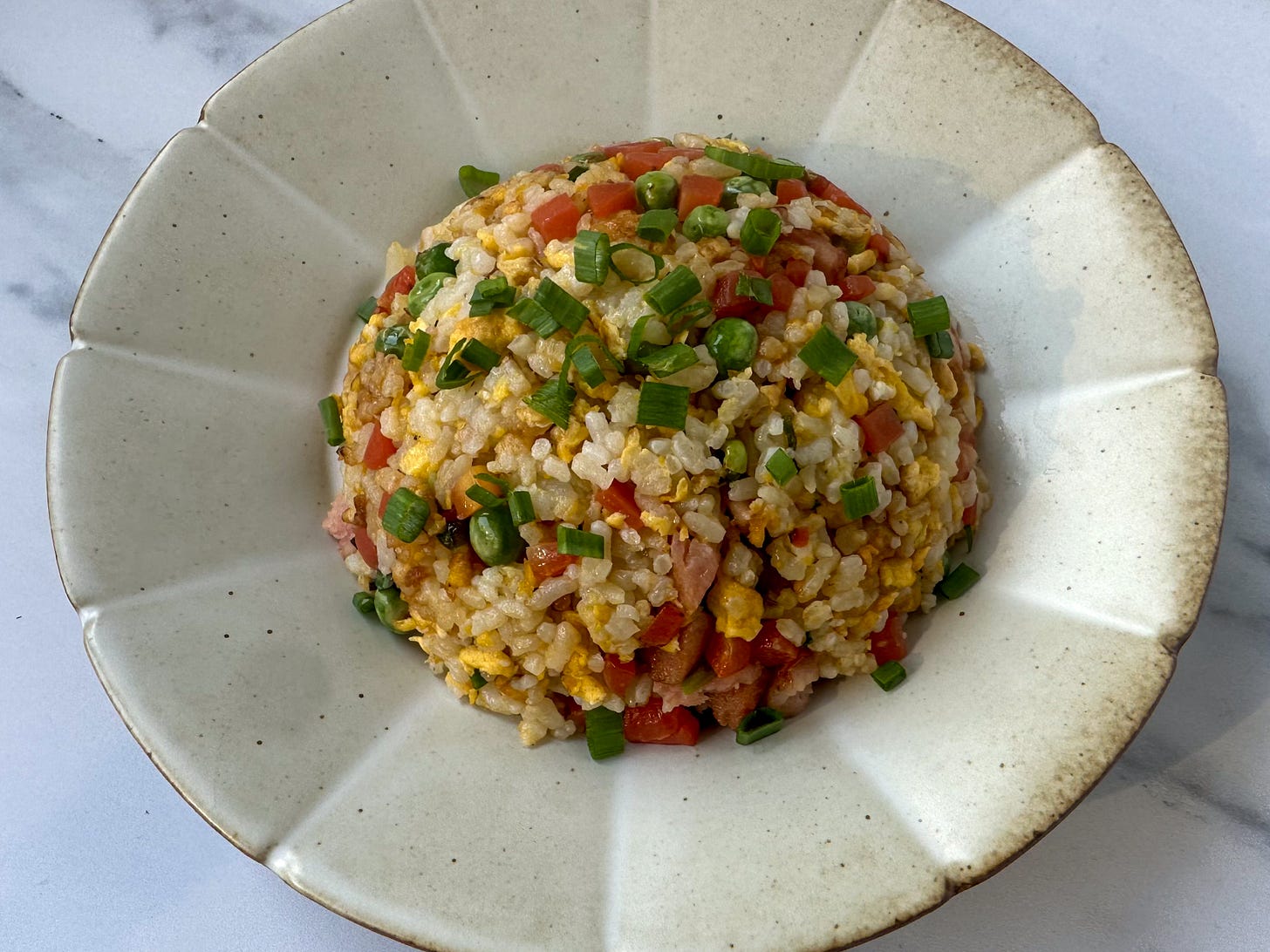
⠀This is not an exhaustive list, so let your creativity flow!
Food writer Shen Jialu (沈嘉禄) wrote in his food memoir about Shanghai that soy sauce fried rice was a classic in Shanghai restaurants (Shanghai Laoweidao, 上海老味道); Wang Zengqi (汪曾祺), another food writer, described how in the countryside of Jiangsu, oil-fried rice was made into children's songs. Of course, many claim that egg fried rice (the famous Yangzhou fried rice) has a long history in China.





